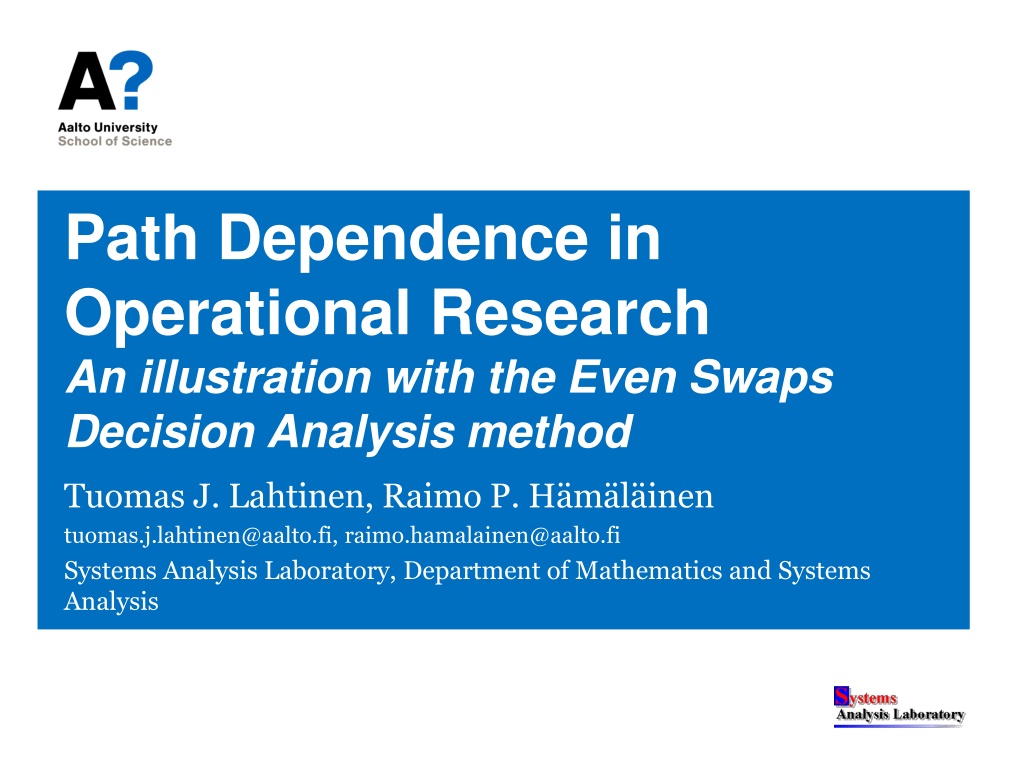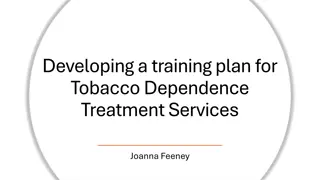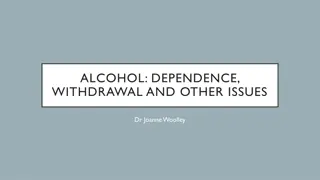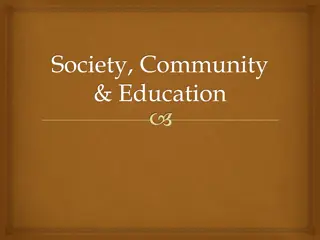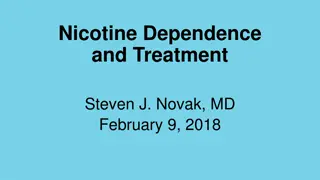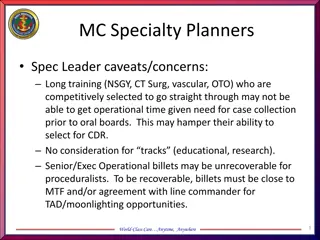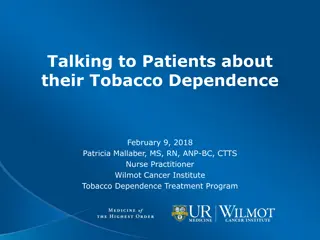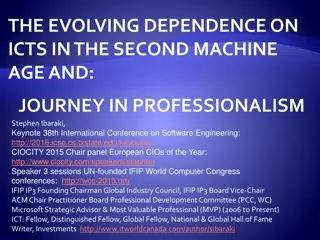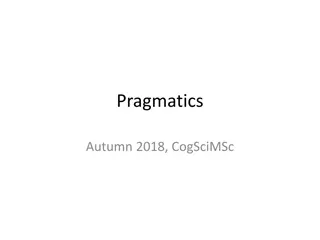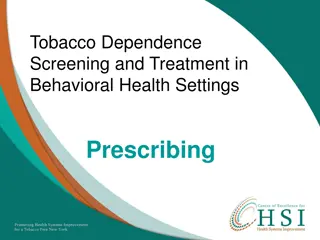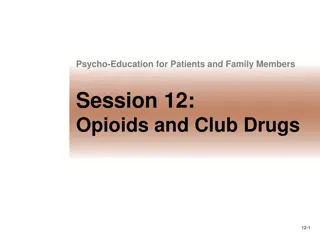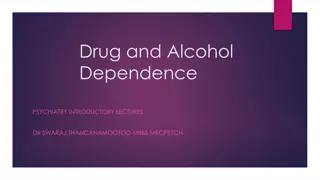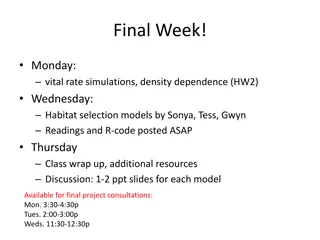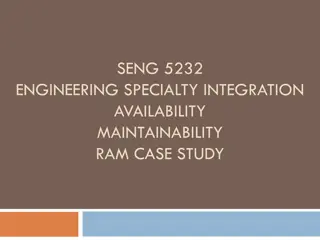Understanding Path Dependence in Operational Research
Path dependence in operational research highlights how the sequence of steps taken in decision-making processes can significantly impact outcomes. This phenomenon, recognizing the influence of history on current states, emphasizes the importance of stakeholder engagement, structuring models, and ethical considerations. While path dependence may not always pose a risk, it underscores the value of exploring different paths for learning and creating shared problem understandings. The drivers and origins of path dependence involve system dynamics, behavior, motivation, and external factors, shaping decision-making processes. Overall, a system formed by individuals involved in problem-solving can exhibit lock-in behaviors, emphasizing the need for adaptive problem-solving approaches.
Download Presentation

Please find below an Image/Link to download the presentation.
The content on the website is provided AS IS for your information and personal use only. It may not be sold, licensed, or shared on other websites without obtaining consent from the author. Download presentation by click this link. If you encounter any issues during the download, it is possible that the publisher has removed the file from their server.
E N D
Presentation Transcript
Path Dependence in Operational Research An illustration with the Even Swaps Decision Analysis method Tuomas J. Lahtinen, Raimo P. H m l inen tuomas.j.lahtinen@aalto.fi, raimo.hamalainen@aalto.fi Systems Analysis Laboratory, Department of Mathematics and Systems Analysis The document can be stored and made available to the public on the open internet pages of Aalto University. All other rights are reserved.
Path dependence Earlier in economics, policy studies and organizational decision making (Arthur 1989, Webster 2008, Sydow et al. 2009) History matters , i.e. current state depends on the history Lock-in phenomena, e.g. QWERTY (David 1985) Photo by Ileana Gonzales, CC BY-NC-ND 2.0
Path in Operational Research The sequence of steps taken in the OR process Stakeholder engagement Framing and structuring Choice of model Data collection and preference elicitation Order of steps in specifying and solving the model
Path dependence in OR: Process outcome depends on the path followed Implicitly recognized already early Best practices: Morris (1967), Pidd (1999) Adaptive problem solving: Little (1970), Ormerod (2008) Model validity: Landry et al. (1983) Ethics: Rauschmayer et al. (2009) Integrative perspective: Path dependence refers to all the phenomena where different paths lead to different outcomes.
Is path dependence a risk? Likely to be in Optimization, efficiency Important policy problems, normative decision support Not necessarily if goal is to increase understanding Learning with modeling Creation of shared understanding of the problem Stakeholder engagement Trying different paths can be beneficial to learning
Drivers and origins System Learning Procedure Behavior Motivation Uncertainty External environment Can interact and occur together
System Formed by the people involved in the problem solving process Lock-in to one approach. Groupthink, working with our models This is the right model Yes Yes Irreversibility. Due to budget, time or resource constraints Yes Yes Yes Also the system under study Mathematical : Increasing returns, bifurcations, feedback loops
Learning Problem owners, stakeholders and modelers learn about the problem: revise assumptions, redirect the process Unlearning preconceived solutions Importance of early framing: Value-focused thinking? Procedure Properties and structure of the procedure used to solve the problem Technical properties, convergence Order of problem solving steps Decomposition into sub-problems
Behavior Cognitive biases: Accumulation of effects Anchoring: Preference elicitation, negotiation, valuation, forecasting Status quo bias, Sunk cost effect: Commitment to previously adopted models and software Motivation People s goals affect the OR process High risk in messy and controversial problems OR expert delivering desired result, confirmation bias Strategic behavior in group processes
Uncertainty and changes in the external environment Uncertainty in assumptions: No one right path, sensitivity to initial modeling choices Changes in external environment: Same path can lead to different results at different times Mitigation Multi-modeling: Use of multiple models in the same problem. To help find path dependence, average results, find robust solutions. Adaptive modeling: Adjust the OR intervention and the model adaptively as the process evolves.
Checklist for the practitioner 1. What is the main goal of the modeling process learning or prescriptive modelling? 2. Is path dependence a real risk and do we want to avoid it? 3. Consider measures and risks related to the system created by the problem solving process 4. Consider procedural, behavioral and motivational biases 5. Consider technical properties, such as irreversibilities, in the problem under study 6. Is it possible to use multiple models? 7. Consider the possibility of an adaptive modelling approach
Illustration with the Even Swaps method Even Swaps (Hammond et al. 1998): Simple, clearly defined paths Well known in the Decision Analysis community Goal: Find the best alternative with multi-attribute evaluation Multiple paths possible Trade-offs between attributes
Even Swap Smart-Swaps software by Mustajoki and H m l inen (2007)
Office selection problem (Hammond, Keeney, Raiffa 1999) 25 78 An even swap Practically dominated by Montana Dominated by Lombard Commute time removed as irrelevant (Slightly better in Monthly Cost, but equal or worse in all other attributes)
Biases in the even swaps Paths consist of different sequences of trade-off judgments (even swaps) Biases: Scale compatibility: Extra weight for the measuring stick Loss aversion: Extra weight for the loss attribute How much should you pay to save 30 minutes of commuting time? Effects of biases can accumulate during the process Different paths favor different alternatives
Experiment 148 students from Aalto university Use Even Swaps method in Apartment selection Job selection Each subject completed both tasks on two or three different paths.
Results 1: Pricing path favors alternatives good in monetary attribute Percentage of subjects who end up with alternatives that are good in monetary attribute 90 80 80 Percentage of subjects 70 * 63 63 *** 57 60 53 ns 50 *** 40 29 30 20 10 0 Job 1 Apartment 1 Pricing IRR path DOM path ns: not significant, *: p-value < 0.05, ***: p-value < 0.001. Based on McNemar s test.
Results 2: All swaps in same alternative this alternative is favored Percentage of subjects who end up with alternative A 60 50 50 Percentage of subjects 40 30 21 20 10 0 Apartment 2 Swaps in A Swaps in B Result is significant with p=0.004. Based on McNemar s test.
Summary of experiment Use of one measuring stick attribute alternatives that are good in this attribute will be favored Explanation: Accumulated effects of scale compatibility bias Many swaps carried out in same alternative this alternative will be favored Explanation: Accumulated effects of loss aversion bias Mitigation: Use measuring stick in which alternatives differ least Conduct swaps evenly in all alternatives Restarting the process after each elimination by dominance
Conclusions Path dependence is a real phenomenon and risk in OR Extra concern in large policy problems and normative decision support Most important driver is likely to be human behavior Exists in the Even Swaps method Awareness is the first step to cope with path dependence Think of the perspectives, use the checklist More research on mitigation needed Challenge to develop methods when path dependence is seen as a risk
Thank you Based on manuscript: http://sal.aalto.fi/publications/pdf-files/mham15b.pdf Photo by Dioboss, CC BY-NC-SA 2.0
Presentation based on manuscript: H m l inen, R.P., Lahtinen, T.J., 2015. Path Dependence in Operational Research - An Illustration with the Even Swaps Decision Analysis Method. http://sal.aalto.fi/publications/pdf-files/mham15b.pdf References: Little, J.D.C., 1970. Models and Managers: The Concept of Decision Calculus. Management Science 16 (8), B466-B485. Reprinted in Management Science 50 (12 Supplement), 1841-1853. Morris, W. T., 1967. On the Art of Modeling. Management Science 13 (12), B707-B717. David, P.A., 1985. Clio and the Economics of QWERTY. The American Economic Review 75 (2), 332-337. Landry, M., Malouin, J-L., Oral, M. 1983. Model validation in operations research. European Journal of Operational Research 14 (3), 207-220. Arthur, W.B., 1989. Competing technologies, increasing returns, and lock-in by historical events. The Economic Journal 99 (394), 116-131. Hammond, J.S., Keeney, R.L., Raiffa, H., 1999. Smart Choices: A Practical Guide to Making Better Decisions. Harward Business School Press, Boston, MA. Pidd, M., 1999. Just Modeling Through: A Rough Guide to Modeling. Interfaces 29 (2), 118-132. Mustajoki, J., H m l inen, R.P., 2007. Smart-Swaps - A decision support system for multicriteria decision analysis with the even swaps method. Decision Support Systems 44 (1), 313-325. Webster, M., 2008. Incorporating Path Dependency into Decision-Analytic Methods: An Application to Global Climate- Change Policy. Decision Analysis5 (2), 60-75. Ormerod, R. J. 2008. The transformation competence perspective. Journal of the Operational Research Society 59(11), 1435-1448. Rauschmayer, F., Kavathatzopoulos, I., Kunsch, P.L., Menestrel, M. Le., 2009. Why good pratice of OR is not enough Ethical challenges for the OR practitioner. Omega 37 (6), 1089-1099. Sydow, J., Schrey gg, G., Koch, J., 2009. Organizational Path Dependence: Opening The Black Box. Academy of Management Review34 (4), 689-709.
